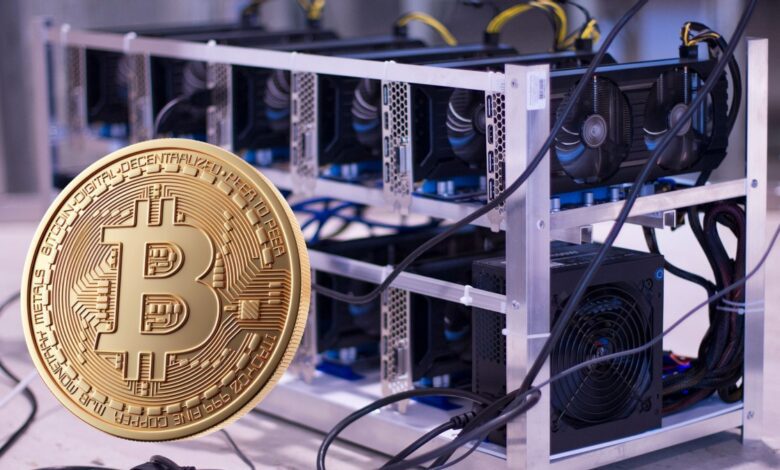2025 Bitcoin Mining Guide: How It Works and How to Get Started
Understanding the process, technology, and economics that power the Bitcoin network.

Bitcoin (BTCUSD) mining is the foundation of the Bitcoin ecosystem. It verifies transactions, secures the network, and releases new Bitcoins into circulation. While the term “mining” suggests a physical activity, the process is entirely digital. It involves solving mathematical puzzles through computers that compete for rewards.
To understand how Bitcoin operates, it helps to first understand the mechanics of mining, why it exists, how it works, and what keeps the system balanced and secure.
Also Read: Why Big Investors Who Can’t Buy Crypto Are Gobbling Up These Stocks Instead
The Purpose of Bitcoin Mining
Bitcoin mining serves three essential functions:
- Verification: It confirms and records transactions on the blockchain.
- Security: It prevents fraud and double-spending.
- Issuance: It introduces new bitcoins into circulation at a predictable rate.
Bitcoin’s creator, Satoshi Nakamoto, designed the network to operate without banks or governments. Instead of a central authority approving transactions, the system relies on miners to validate and group them into “blocks.”
Each block added to the blockchain strengthens the system’s trustworthiness. The miners who complete this process are rewarded with newly minted Bitcoins and transaction fees. This design keeps participants honest, as anyone attempting to cheat would need to control most of the network’s computing power, a practically impossible task.
The Mechanics of Bitcoin Mining
At its core, mining is a competition to solve cryptographic puzzles. Every time a batch of Bitcoin transactions is ready to be confirmed, miners compete to find a solution to a mathematical problem based on the SHA-256 hashing algorithm.
Here’s how the process unfolds:
- Transaction Collection: Pending transactions are grouped into a block.
- Hashing: The miner takes the block’s data and repeatedly runs it through the SHA-256 function, producing a new hash with each attempt.
- Target Matching: The goal is to find a hash with a value below a specific target set by the network. This requires trillions of random guesses.
- Block Validation: When a miner finds a valid hash, they broadcast the result to the network.
- Reward Distribution: The successful miner receives the block reward plus all transaction fees in that block.
This constant guessing consumes large amounts of energy, but it also ensures that adding new blocks requires real work. That’s why the system is called proof of work.

What Miners Earn
Each new block rewards miners in two ways:
- Block Reward: Newly created Bitcoins (currently 3.125 BTC per block).
- Transaction Fees: Small fees users pay to have their transactions included faster.
Bitcoin’s supply is limited to 21 million coins. Every four years, the block reward halves, a process known as the halving. This event slows the rate of new supply entering circulation and is key to Bitcoin’s scarcity.
Example:
- In 2012, miners earned 50 BTC per block.
- In 2016, that dropped to 25 BTC.
- In 2020, it fell to 6.25 BTC.
- In 2024, it halved again to 3.125 BTC.
The next halving in 2028 will reduce the reward to 1.5625 BTC. Over time, miners will rely more on transaction fees as the main incentive.
Evolution of Mining Hardware
In Bitcoin’s early days, hobbyists mined with standard CPUs on home computers. As competition grew, miners adopted more efficient equipment:
- CPUs (2009–2010): Early stage; low difficulty and minimal competition.
- GPUs (2010–2011): Graphics cards processed many hashes simultaneously, offering 50–100x more power than CPUs.
- FPGAs (2011–2012): Programmable chips optimized for better efficiency.
- ASICs (2013–present): Application-Specific Integrated Circuits designed solely for mining, offering trillions of hashes per second.
Example:
A modern ASIC miner like the Bitmain Antminer S21 can perform over 200 trillion hashes per second while consuming around 3,500 watts. That’s roughly 100,000 times faster than a standard laptop processor.
Due to their cost and energy requirements, most mining operations now occur in data centers located near inexpensive or renewable energy sources.

Mining Pools Explained
Solo mining has become nearly impossible for individuals. The chances of a single miner finding a valid block are microscopic compared to large-scale operations. To improve their odds, miners join mining pools.
Mining pools work by combining the computing power of many participants. When the pool mines a block, the reward is divided based on each miner’s contribution.
Benefits of joining a mining pool:
- More consistent earnings (smaller but regular payouts).
- Lower variance in results.
- Simplified setup, since the pool handles coordination.
Example:
If a pool earns 6.25 BTC and you contributed 2% of its total computing power, you receive 0.125 BTC before fees.
Popular pools include Foundry USA, AntPool, F2Pool, and ViaBTC. Together, they control most of Bitcoin’s global hash rate.
Energy Use and Environmental Debate
Bitcoin mining consumes significant electricity. Estimates vary, but global consumption often compares to that of entire nations such as Argentina or the Netherlands.
This has raised concerns about environmental impact, but context matters. Many mining operations already use renewable or wasted energy sources, such as:
- Hydroelectric power from remote dams in Canada or Norway.
- Wind and solar energy in Texas and Kazakhstan.
- Flared natural gas from oil fields, where energy would otherwise be wasted.
Miners seek the lowest possible energy costs, which often align with clean or surplus energy sources. In regions with excess renewable generation, mining can help stabilize grids by absorbing unused power.
Still, debates over sustainability continue. The industry’s shift toward renewable energy and efficiency improvements will likely remain central to its future.
Also Read: How to Capitalize on the Five Pillars of Growth in the Red-Hot Wearables Market
Mining Difficulty and Network Balance
Bitcoin automatically adjusts its mining difficulty every 2,016 blocks, roughly every two weeks. The goal is to maintain an average of one block every ten minutes.
If miners add more computational power to the network, difficulty increases. If they drop off, the difficulty decreases. This ensures steady, predictable operation regardless of how many miners participate.
Example:
If Bitcoin’s total hash rate doubles, the difficulty will eventually double as well. This prevents blocks from being mined too quickly and keeps Bitcoin’s supply schedule on track.
Why Mining Keeps Bitcoin Secure
Mining’s competitive structure makes Bitcoin extremely difficult to attack. Each block of transactions is linked to the previous one through cryptographic hashes. Changing a single transaction would require re-mining every block after it, a task that would demand control over 50% of the entire network’s computing power.
This is called a 51% attack, and it’s largely theoretical at Bitcoin’s current scale. The cost of mounting such an attack would exceed any possible financial gain.
Bitcoin’s decentralization, tens of thousands of nodes and miners worldwide, creates resilience unmatched by traditional payment systems.
How to Get Started in Mining
For those interested in joining the mining ecosystem, here’s a simple overview of the process and considerations involved.
1. Choose Your Approach
- Solo mining: Directly competes for block rewards. Rarely profitable for individuals.
- Pool mining: Easiest option for beginners. Join a group and share rewards.
- Cloud mining: Rent computing power from a provider, though many such services are risky or unreliable.
2. Select Mining Hardware
Options vary by budget and electricity access:
- Entry-level: Older ASICs (Antminer S9, Whatsminer M20S) can be affordable but less efficient.
- Mid-range: Antminer S19 or Whatsminer M30 series balance efficiency and cost.
- High-end: Antminer S21 or similar devices for industrial setups.
3. Calculate Profitability
Use online mining calculators, such as ASIC Miner Value or WhatToMine. Input:
- Device hash rate
- Power consumption (watts)
- Electricity cost per kWh
- Pool fees and Bitcoin price
4. Choose a Mining Pool
Popular and trusted options include:
5. Set Up Software
Mining software connects your machine to the pool. Examples include:
- CGMiner
- BFGMiner
- Braiins OS (open-source firmware for ASICs)
6. Manage Heat and Power
- Ensure proper ventilation and cooling.
- Use surge protection and stable power sources.
- Monitor temperatures regularly to prevent hardware damage.
7. Secure Your Earnings
- Use a Bitcoin wallet (hardware wallets like Ledger or Trezor are best).
- Withdraw mining rewards regularly to minimize the risk of online theft.
Example Setup:
A miner in Alberta with access to $0.05/kWh electricity could run three Antminer S19 devices, producing around 0.0004 BTC per day, or roughly $15–20 in daily revenue depending on Bitcoin’s price and pool fees.

The Future of Bitcoin Mining
As Bitcoin’s block rewards decline, the system will rely more heavily on transaction fees. Some predict the network could sustain itself entirely through fees once all 21 million Bitcoins are mined (around the year 2140).
Advances in efficiency, renewable energy integration, and chip design are shaping a more sustainable future for mining. Some companies are experimenting with immersion cooling and hybrid energy systems that recycle heat for other uses, such as greenhouse heating or building power generation.
Meanwhile, the economics of mining continue to evolve. Institutional investors now back large-scale mining farms, and publicly traded companies, such as MARA Holdings (NASDAQ: MARA), Core Scientific (NASDAQ: CORZ), CleanSpark (NASDAQ: CLSK), Cipher Mining (NASDAQ: CIFR), and Riot Platforms (NASDAQ: RIOT), compete for dominance. Smaller operators still exist, especially in regions with access to cheap, renewable energy and cooler climates that reduce cooling costs.
Final Thoughts
Bitcoin mining is the heartbeat of the world’s first decentralized financial network. It transforms electricity into digital scarcity, ensuring that every transaction is verified without relying on trust or intermediaries.
Understanding how mining works provides insight into what makes Bitcoin secure, valuable, and resilient. Whether you’re a beginner exploring the concept or an investor analyzing the industry, mining remains one of the most innovative and misunderstood processes in modern finance.
Bitcoin mining sustains the integrity of a system built on math, transparency, and global cooperation.
Small Cap News Movers & Winner Deep Dive – By WealthyVC.com
We scan over 10,000 publicly listed stocks across all seven North American exchanges to uncover the market-moving news that actually matters—focusing on high-quality, liquid, growth-oriented companies in sectors attracting serious capital, like AI, blockchain, biotech, and consumer tech.
Each week, we publish Small Cap News Movers, a curated roundup of small and micro-cap stocks surging on meaningful catalysts. We break down what’s driving the move, tap into rumors swirling on social media, and surface sharp insights from both industry experts and retail sleuths.
From this list, we select one standout stock for our Small Cap Winner Deep Dive, released the next day, where we take a closer look at the fundamentals, narrative, and technicals that suggest this winner could keep running.
Powered by our proprietary 4-element, AI-driven analysis system, our goal is simple: cut through the noise, remove the emotion, and help investors dominate the small-cap market with momentum-driven strategies—completely free.
Sign up for email alerts to get the moves before our social media followers.
Read Next: Why Nvidia’s Tech Investments Could Transform the Entire AI Innovation Ecosystem
Join the Discussion in the WVC Facebook Investor Group
Do you have a stock tip or news story suggestion? Please email us at: invest@wealthyvc.com.
Disclaimer: Wealthy VC does not hold a position in any of the stocks, ETFs or cryptocurrencies mentioned in this article.




